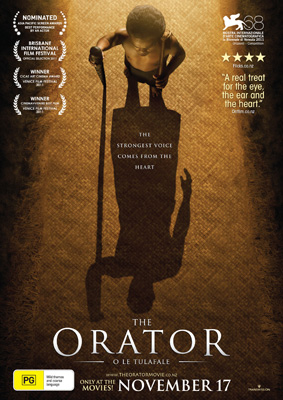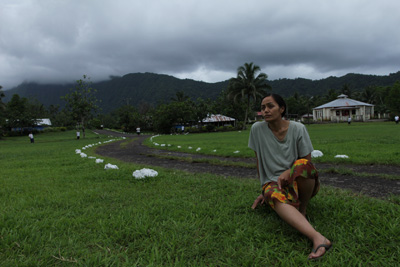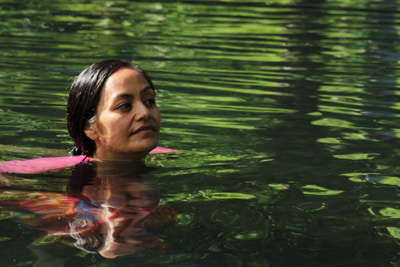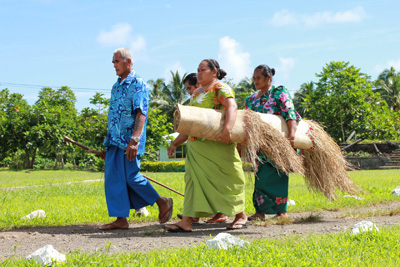The Orator

The Orator
Cast: Fa'afiaula Sagote, Tausili Pushparaj, Salamasina Mataia, Ioata TanieluDirector: Tusi Tamasese
Genre: Drama
Running Time: 110 minutes
Synopsis: 17 years after Vaaiga was banished from her ancestral village, three large and intimidating men, including her older brother Poto, arrive at Saili's house and forever change their quiet lives. Saili hides in his taro patch while Vaaiga, his wife, is left to confront these unexpected visitors. Poto, who is sick, demands Vaaiga, return with him and restore him and their family to health. Vaaiga refuses, determined to stay with her 17 year old daughter, Litia, and her beloved husband Saili. Saili fears he has neither the strength nor the status to defend himself and his family, for he is a little person. Without his deceased father's chiefly status, he is simply a taro farmer. Already his neighbours are encroaching on his land, disrespecting the graves of his parents and now his wife is being threatened, because Poto will return. Tagaloa, the paramount village chief, who protects Saili within the village, is aging fast.
Encouraged by Vaaiga to make a stand, Saili summons his courage and decides to seek his father's chiefly title but Tagaloa refuses, ridiculing his request. He does not believe Saili has either the required physique or the skill in oratory expected of the role. When the threats to his family escalate, Saili takes on the attackers, but his bravery results in a vicious beating and public humiliation. Without hope of defending his family and land Saili is tempted to give up. Suddenly, Vaaiga dies and Poto, her brother, returns and steals her body.
Saili, tormented by his failure to protect their love, faces his fears and seeks once more a chiefly title, determined to use it to reclaim Vaaiga. At Poto's village, Vaaiga's funeral is underway. While Saili summons the courage he will need to stand up and face this crowd, a delegation arrives from the village council led by a senior chief, Fousaga. Poto's artful oratory successfully defends the family's right to bury their banished sister with them. And then, amid laughter and mockery, Saili stands and faces Poto. His words speak of a love which defeats all possible gifts or argument. He wins Vaaiga back, death will not part them and the family will remain together.
About the Production
The Orator (O le Tulafale) was filmed entirely on the island of Upolu, Samoa. The various locations were found in the villages of Manunu, Vailele, Satapuala, Faleapuna, Vaitele.Tusi Tamasese Talks About The Film
The Orator (O le Tulafale) is the story of a man, Saili, who wants only to defend the honour of his beloved wife and be at peace with her.
Saili is physically disadvantaged, with no great aspirations or expectations for himself and yet he is confronted with overwhelming adversaries and miraculously, through willpower, spirit and love for his beloved Vaaiga, he becomes an unlikely hero at the end. It is a story about confronting self-doubt, distrust and prejudice - an underdog story set in an exotic place.
The story takes place in a small village in Samoa. The landscape, people, culture, images, colour, sound and feel of Samoa offer this story a new and unique perspective of life. In this film Samoa is a character.
This film is a folktale and a lullaby. Beneath the exotic setting are universal themes of the strength of the human spirit and love.
The film is visually rich and entertaining. My objective is to take the audience into a world filled with rich and witty dialogue, fresh and unpredictable characters. A world that showcases simplicity and hardship of life, and the strength of the human spirit A world where the bond between the living and the departed remains unbroken by death. A world that is funny with its dark humour, brutal and violent in its human tragedy. A world that is distant and far but yet the struggles and victories of the human spirit are so close and so familiar.
From the moment the film starts we set upon a journey alongside Saili and Vaaiga to discover their love for each other and the life threatening situation life has place them in. I want to bring the audience as close as possible to Saili and to see things from his perspective. I want the audience to know and understand Saili's place in the world. Saili is a night watchman at the local shop, which involves the simple act of watching things. This is the nature of his character; he is not a reactor or fighter. He has no power but is placed in situations to protect and defend.
The Shooting Style
What is the world like when you're a little person? How do you see the world from down there? Is it dusty and hot being close to the ground and what does it sound like? In Samoa trying to be low to the ground when crossing in front of people sitting is a sign of respect and being humble. In a way Saili possesses this humility and quietness. This lead me to take on a style where the world Saili occupies is separated from the rest of the normal villagers into "strata".
Characters are enveloped or immersed in the world they inhabit. These include shots of characters under taro fronds or in the middle of a yam field, or in the middle of a freshwater pool. Mother Nature plays the role of life giving, neutraliser, destroyer, and of death in the film as we see in the first few minutes of the film.
I admire the shooting styles of Tarkovsky and Kurosawa. I love the humour of the Coen brothers. I am a fan of Tarantino's and Kitano's violence. I am a fan of foreign and mainstream films. I was interested in these filmmakers and how they capture and portray the worlds of their films. I have always been a fan of wide and long takes/shots. I love seeing suspense and drama unfold infront of spectators. It is a style that I have tried to incoporate in the film.
I wanted to establish spaces and see the love that exists in that space. The Orator shows love and affection through peaceful silence, quietness and space. This is the challenge, where there is no intimate touching or affectionate dialogue to show that true love is shared by these unlikely lovers. I have incorporated Samoan customs in the shooting style of this film, especially around people having conversation - in this film characters don't have face to face conversations.
I think the challenge as a director, is to make this film a Samoan film - from a Samoan storyteller. To establish a style of filmmaking that is derived from culture and customs of Samoa and that eqaully tells a Pacific Island story that the whole cinema world can understand and appreciate . Hopefully The Orator will pave the way for that.
I believe that in all of us there is a 'dwarf' a metaphor for things that hold us back. This could be our culture, our jobs, lack of confidence or the lack of courage etc. These things can hold us back and limit our expectation and ambitions in life, which I think is something that many of us PIs (Pacific Islanders) can identify with.
 The Design and Yse of Colour
The Design and Yse of ColourI wanted to play with symbolic and metaphoric ideas using the Samoan landscape and settings. The design of the living rooms, the size and shapes of the windows and doors, the circle of pillars that hold the powerful chief Tagaloa prisoner or the taro fronds and looming coconut plantations are images that will have symbolic and metaphoric meanings.
The house of Saili and Vaaiga has metaphor and symbolic meanings. A Samoan home is designed to be open due to cyclones and hurricanes. Soft breeze and strong winds will flitter through and do little damage to the house. The open windows and doors of Saili's house also invite village gossip and life as well. We hear villagers chatting as they walk along the road in front of the house.
Samoa is a very colourful country. The greenness of the forest and villages is enhanced after rainfall. In the dry season the dry dust is evident. The villages are spectacular with homes, graves, rock fences and even trees coloured in blue, orange, yellow, green, the colours of nature in Samoa.
I also played with symbolisms in colour. The most obvious element to me is the colour green. Green is a dominant colour in Samoa, sometimes the sea turns green, the landscape is green - to me it represents growth and resilience. Pink is a subtle colour in the film which, it is most significant to the journeys of those characters who wear this colour in the film.
Costume was another important element. For the character of Vaaiga who is dying, the colours in her clothes begin to fade as her health fades.
In Samoa, people wear colourful lava-lava and T shirts. I wanted all colours to be neutral. I did not want to allocate blacks to villains and whites to the goodies in the film. Evil is not colour blind. On the other hand, I pick the most innocent of colors, pink, as the color that represents death in the film. Not only does the dying Vaaiga wear this color but also the old chief Tagaloa, to symbolise his nearing the end of his life or journey. On the other hand, the color white is used dominantly for the graves. A white colored grave illuminates in the darkest of night.
One of the underlying stories in the film is that women don't become orators. In the scene where Vaaiga is preparing to see her brother Poto for the first time, she puts on a shirt - a symbolic gesture. When we see the three chiefs confronting her inside the house, they are all in shirts. Women are as good as male orators but, as Tagaloa says, are ashamed to show their breasts in public.
The Use of Light
As much as possible I used natural and naturalistic lighting. I think the most important and trickiest location in this film is inside the living room. There are a lot of things happening here. I want to emphasise the gradual development from daytime to night time through the movement of sunlight. I want to see the shadows on the faces of the characters and the shadows on the floor and mat wall. Most important is the relationship between Vaaiga and the living room. I wanted the living room to be connected to Vaaiga and reflect her strength, her struggles and weakness. When Vaaiga is feeling her worst I wanted the room to enhance this feeling. I wanted to cast shadows at the edges or the corners of the living room as if reaching for her. I wanted to see pools of light from the windows and door cast on the cool ugly concrete floor. I wanted to feature this struggle between light and darkness - reflection of the struggle between death and life in Vaaiga.
The Sound Design
The sound of this film is "Samoa". The sound of villages in the night is different from the sounds of day, the tapping of falling leaves or rain droplets on the tin roof. The sound of silence between lovers is different. The voices of the people chanting and chatting in our language as well as hymns in the evening are uniquely Samoan. I want to immerse the audience into the world of our story.
The use of the Island weather pattern is also a feature in this film. For instances, rain can be cleansing but also hard and threatening. Rain is a ghostly character that brings life but also can take it away. It is a link between heaven and earth. Its natural rhythm and power is used to emphasis the emotional change in eg the violence of the rain when Poto takes Vaaiga's body.
Silence is power. These characters don't say much, their words are either heard in the body language or spoken through the subtlety in their facial expressions or through delicate skill of the composer.
The two main characters, Saili and Vaaiga are given distinct and separate sounds or tunes or instruments (wind instruments - eg nose flute and conch). These instruments or tunes accompany each character but never come together. It is only at the end when the hero has won that these instruments merge to create a beautiful tune or melody - but very subtle.
Night is the time of spirits and demons. I wanted to create this supernatural world but use natural sounds. Giant flying fruit bats fighting over ripe fruit adds a nice threatening and mysterious sound through the night as Saili sits alone at the shop. The crickets that sound the arrival of evening and dusk.
The Language of the Film
To me, language is most satisfying when it's spoken in the native tongue of those being portrayed in the film. Language is made up of metaphors, rhythm, pace and poetry. Language comes from the land and culture. Being a Samoan from Samoa, I cannot find the meaning or the essences of my culture, land and people if the characters in my films speak a language not their own.
Language brings meaning to the characters and in turn the characters to the story. The language is an ingredient that is essential to the mixture in order to make the film true and believable. The tones, the sound and mannerisms of speaking one's language are unique. One of the reason I love Japanese films is because of the way they speak and the sound of the language - I can understand meaning but not the words.
There are two forms of Samoan language in the film, the everyday language spoken casually and the Chiefly oratory spoken in special occasions. The latter is filled with formal words metaphor, poetry and stories.
 The Music
The Music Much of the music in this film can be derived from everyday sounds such as the drumming of the can or mat while a group of young men cut the grass of a large yard. The rhythm and beat of the drumming is haunting and can accompany any emotional or tense scene in the film. Family hymns sound at dawn and at dusk through every village.
I also wanted to use a variety of Samoan music and instruments to distinguish different elements in the film. New urban Samoan (rap) music plays on the bus. Every time the bus goes through the village we hear these thumping beats. The bus represents urban life. The fast thumping beats of urban life are totally different from the rhythm of village life. The village is represented by old Samoan music with just the mat, guitar and vocals.
The soundtrack of the film incorporates Samoan instruments like the conch shell, which is used to sound the beginning and ending of the evening curfew.
Casting and Character Notes
Shooting in Samoa with a predominantly local untrained cast, I was overwhelmed by how well the actors took directions and how they understood and related to their characters and their emotional state. They each brought a look, experience, mannerisms and behaviours to their roles that made the characters so natural and authentic and brings depth and truth to the story.
I believe there's a freshness and powerful presence on screen when using untrained actors. The reactions and behaviour are very raw and unpredictable. They offer a sense of innocence but also of hidden strength in their eyes and their bodies. I love the way they look, the glare in their eyes, the scar on their face, the shape of their feet and the thickness of the skin on their hands are all elements that contribute to bringing the character to life.
The experience in making my short film Va Tapuia gave me confidence that the main cast for The Orator - Saili, Vaaiga, Tagaloa and Litia could be all locally cast in Samoa. For me as a writer/director, they bring more to the story than what I have written.
Saili
"who am I?"
"…his parents had died a few years past and he was living alone. But now there was a 17 year old girl a bit older than him and her new born baby living in his house. He was kind enough to let them stay and provide for them until both were healthy enough to travel and continue on their journey to where ever they were destined before stepping off that bus. But the girl and her baby never left and Saili, a shy and humble young man could not find the courage to tell them to leave. He was becoming accustomed to them and they grew closer and became a family".
All he wants is his family, his beloved wife, step daughter and peace. He is not a typical chief because he cannot con or manipulate. He is not fantastic with words; he is a plain man but with a heart and truth which he speaks without any decoration and wrapping.
Saili is 32 years old and a dwarf. His father was an orator who did not hold a significant chiefly title but a minor one that offered him land. The father had no expectation of his son becoming a chief. So both parents were buried in the plantation to deter invaders and protect the land.
Saili is quiet and keeps to himself. He has accepted his place in the village. No one, not even himself, has any expectation of him. He has never thought of himself as a chief. Being surrounded by tall lean and large men, a dwarf cannot be seen or heard, he cannot have mana, authority or the respect of the people. So far there is no record of a dwarf becoming a Orator chief.
I always believe in the saying that a noisy man can never hear his own echo. Saili is a quiet man and a watcher. He is not a protector or reactor when he is placed in situations that require him to do so - a night watchman at the local shop and a father to his family. His greatest attribute is his love for Vaaiga, and his biggest weakness is overcoming his fear of himself and finding the courage to show that love. Saili's ability to speak his heart and speak the truth is a sign of great honorable and loving husband and father
Saili, like Vaaiga, has several flaws which he needs to overcome before becoming a chief. When he ignores his opponents during the forgiveness ceremony, Saili fails to become the better person and in his search for vengeance he deserts Vaaiga at her most vulnerable moment. Unfortunately it takes Vaaiga's death for Saili to become worthy and better than the others.
What I love about Saili is that given his physical disadvantages he tries hard to be courageous and defend Litia's honour. Saili is the ultimate underdog.
 Vaaiga
Vaaiga "stones decay, words don't"
"…A seventeen year old girl steps off a bus. The bumpy road offers no help to her increasing labour pains. She stumbles onto a yard seeking help. A dwarf came to her aid and took her into his house. A village midwife was brought to bring the baby girl into the world. The 17 year old mother never saw the kindness of a dwarf, but of a young man, from then on."
Vaaiga is a beautiful 35 year Samoan woman, tall and slim with long black hair that falls down her back.
She was born in Mulifanua, Upolu, the daughter of Seuseu and Neta Maliumanu, the newly appointed pastor of Mulifanua Congregational Christian Church. Neta is a native of Mulifanua. Vaaiga is the youngest and only girl of four siblings. She had rheumatic fever when she was five. Doctors predicted that she would not reach the age of seven. The fever had left a hole in her heart.
I think the most beautiful thing about Vaaiga apart from her looks is her ability to forgive, especially because it comes from a weak heart. But also because she has lived a very difficult life where she has never been forgiven for what she did 17 years ago. At 17 Vaaiga got pregnant and was banished by her strict family and birth village. The father of the baby was never banished.
She has many faults. She scorns, she mocks, she is ashamed of Saili seeing her family, she encourages Saili to fight (she gathers rocks for him), and she's the only character who bad mouths Tagaloa. Her strong presence is due to the fact that she challenges things like church donations and chiefly men like Tagaloa. I think her voice represents the new age Samoans who are slowly challenging the old ways of their parents. These new age Samoans are frowned upon for their disrespect of traditions and Samoan ways and they become outcasts.
Vaaiga's ultimate fear is being alone and neglected which is how we first see her in the beginning of the film. Her death is sudden and sad, part of it was her weak heart, and part of it was sadness in seeing Saili and Litia failing to forgive the men outside.
Vaaiga is always shadowed by death. In the living room, the battle of sunlight and shadow is fought around Vaaiga who sits in the middle. Later on she retreats to the dark gloomy mat room and dies. Rectangle shapes are either in the foreground or background in her shots. And even in her dialogue, she speaks of death as if she knows it is coming for her. But she is not afraid of death.
She is now buried in the front yard, just beyond the door steps of her home in Leone.
Litia
Litia does not want to end up like Vaaiga. Not necessarily end up with a dwarf but someone who is no one in the village. This is why she wants to be with Sio. Sio is everything Saili is not.
She tries to be part of things, like the village and Sio. However, Litia has everything she wants right under her nose but only realises this at the end. There are two things Litia shares with her mother - beauty and remorse. Behind all the manipulation and the search for acceptance, Litia is a good girl, she loves Vaaiga very much and she will learn from her mistakes.
Poto
An honourable antagonist. The brother of Vaaiga who failed to defend her when she was banished 17 years ago, Poto is a magnificent conductor of words and can defeat any chief on the orator battle arena, as long as that chief is not a woman. His inability to defeat any of the women in the film is one of the many features of this large character. Poto is superstitious and fears death. He fears his parents have cursed him for neglecting Vaaiga too long. He sees the chaos in his family, the wound on his leg as a curse and sickness from the grave. This drives him to succeed in bringing Vaaiga back to appease the restless parents. The character of Poto is complete, he commits an evil action even though it has merit but he also finds resolution and peace.
Tagaloa
Tagaloa is at the twilight of his reign as the title holder of the Tagaloa family title. He is a prisoner inside his large and fading traditional house surrounded by wooden rotting pillars. He is troubled that his status and power has been dwindled down to solving a rodent problem his adversary is facing with his hidden food. Tagaloa represents the old culture and traditions, which have been filtered and moulded by Christianity through the years. He is what many new age Samoans see as a drain - cultural and family obligations burden many Samoan families financially.
Tagaloa can only sit and watch as his old ways are fading before him, as when he gives Saili a title and he lets his womanly son do a maidens chore. Tagaloa even goes as far as to accept defeat by carrying the cup to a new generation of chiefs.
Sio
Sio is actually the real dwarf of the film. He is the opposite of Saili, where he believes he can be and have anything. He is the village jock, the star player who is banned from playing the most important game of his life.
MORE



